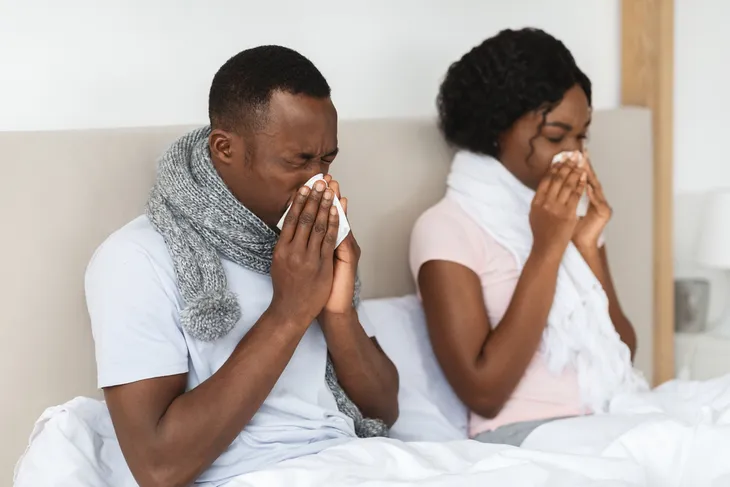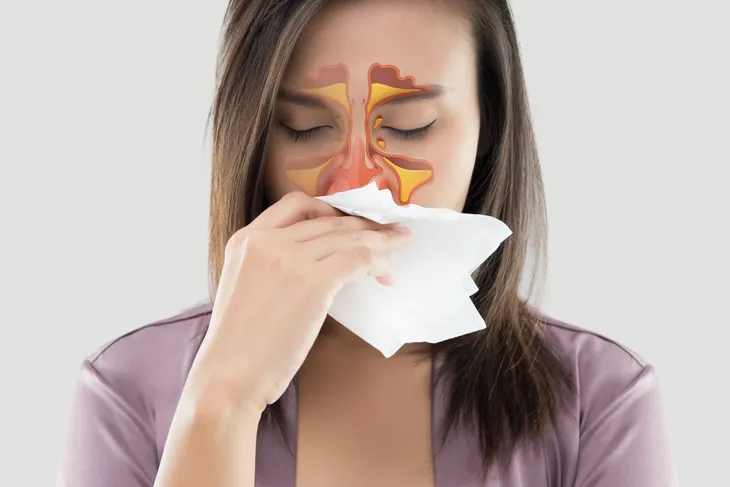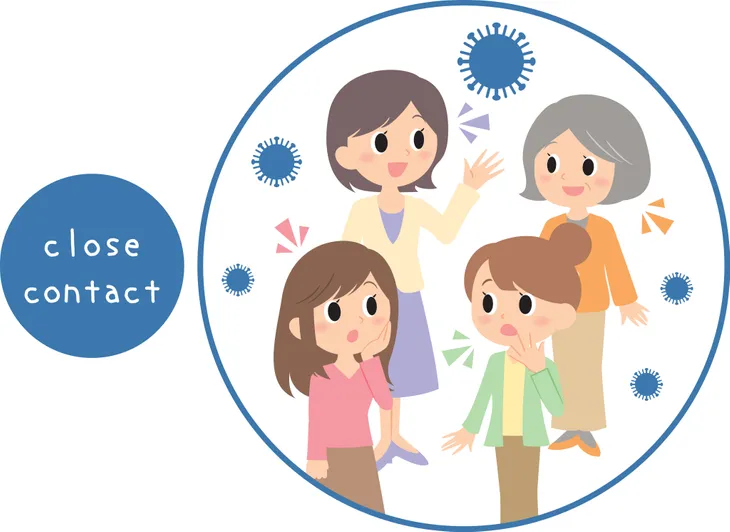- Sinus infections and colds share similar symptoms but there are subtle differences that can help you tell them apart.
- The main difference is that a sinus infection is an infection of the sinuses, whereas a cold is a viral infection of the upper respiratory system.
- Treatment can also vary, especially if you’re battling a bacterial sinus infection.
Dealing with a runny nose and headache is not fun. But how do you know if you’re battling the common cold or a sinus infection? Though they are different, the symptoms can often overlap, making it hard to tell the difference. But there are hints that can help you tell them apart. Knowing which type of infection you’re fighting is also important because treatment can vary depending on which bug you’re fighting.
Follow along as we outline the major differences between a sinus infection and a common cold. We’ll find out which symptoms overlap and which ones differ. We’ll also look into how they’re treated and what you can do to prevent getting sick in the first place.
Sinus Infection vs. Cold: What’s the Difference?
The common cold is a minor infection caused by a virus that develops in your upper respiratory system. Pinpointing which virus is causing your infection can be difficult as there are over 200 different viruses that can cause a cold. That said, rhinovirus is the most common cause, accounting for 10- to 40-percent of cold cases.
A sinus infection, also known as sinusitis or rhinosinusitis, develops when your nasal cavities become inflamed and infected. Essentially, fluid builds up in your sinuses, which can become a breeding ground for germs, resulting in a sinus infection. It can be caused by a bacterial infection, however, it can also be caused by a virus or fungus. Because of this, a cold can sometimes develop into a sinus infection.
Types of Sinusitis
There are several types of sinusitis and while they share similar symptoms, the severity and duration of those symptoms will vary. Healthline says the following are types of sinusitis:
- Acute sinusitis is typically caused by a viral infection or seasonal allergies and it has the shortest duration (usually lasting anywhere from 10-days up to 4-weeks).
- Subacute sinusitis usually develops from seasonal allergies or bacterial infection and lasts up to 12-weeks.
- Recurrent acute sinusitis occurs when you have at least four episodes of acute sinusitis in one year (episodes must last at least 7-days).
- Chronic sinusitis lasts for more than 12-weeks but symptoms are usually less severe than acute sinusitis. This type often occurs with persistent allergies or structural nasal problems but a bacterial infection can be the cause too.
What Are the Signs of a Common Cold?
Colds are very common. In fact, the Centers for Disease Control and Prevention (CDC) states that adults get about two to three colds per year. Children have even more! The source says symptoms typically peak within 2- to 3-days and may include:
- Stuffy nose
- Runny nose
- Coughing
- Post-nasal drip
- Watery eyes
Two notable symptoms that don’t often occur in a sinus infection are sneezing and a sore throat. Although, a sore throat may occur in a sinus infection if you’re producing a lot of postnasal drip (when mucus gathers and drips down the back of your throat). This may cause your throat to feel “raw and uncomfortable,” notes the source.
It’s also possible to develop a fever with a cold, although the source says it’s not very common. Symptoms can also sometimes linger for 10- to 14-days.
Common Signs of a Sinus Infection
Though sinus infections can share similar symptoms to the common cold, there are subtle differences. For starters, a sinus infection often causes facial pain or pressure. Healthline explains that your sinuses are ” air-filled cavities located behind your cheekbones and around the eyes and forehead.” So, when they become inflamed, this can lead to facial pain.
The source also notes that sinus infection may cause pain in your teeth (even though your teeth aren’t affected by the infection). Sometimes sinus infections can also cause bad breath or a sour taste in the mouth. This is more common when you’re experiencing a postnasal drip.
How Mucus Differs In a Cold and Sinus Infection
Mucus can occur in both sinus infections and colds but there are some differences. In a cold, the CDC says the nose first makes clear mucus, which helps “wash the viruses from the nose and sinuses.” However, it’s also possible for the mucus to change color after a few days. It may begin to appear white, yellow, or green. The source says when it transitions like this, it’s normal and not a sign of a bacterial infection.
Infectious sinusitis, on the other hand, commonly causes thick greenish-yellow mucus, says Healthline. This is a sign of a bacterial infection.
Are Colds and Sinus Infections Contagious?
It’s no secret that colds are very contagious. Viruses that cause the common cold spread from one person to another through air and close contact. It’s commonly spread in daycare settings and schools, however, anyone of any age can get them.
Sinus infections can be contagious too if they’re caused by a virus. Bacterial sinus infections, on the other hand, are not contagious because the infection forms in the nose and not from an outside infection. That said, the underlying cause that caused the infection in the first place (such as a cold or flu) can be contagious.
When to See a Doctor for a Cold
Most people don’t need medical attention for a cold as it usually resolves on its own. But there are some signs that can indicate it’s time to see a doctor. For starters, the Mayo Clinic says adults should seek medical attention if their symptoms worsen or fail to improve. You should also see a doctor if you develop a fever greater than 101.3-degrees Fahrenheit that lasts for more than 3-days.
The American Academy of Pediatrics says that children under 3-months should be seen by a doctor as the first sign of illness. It can be hard to tell if infants are very sick and colds can quickly develop into serious problems. The source notes children older than 3-months should be seen by a doctor if they’re breathing fast or having trouble breathing. They should also be seen if they have nasal mucus that lasts longer than 10- to 14-days, have ear pain, a cough that lasts longer than a week, or if they have a fever over 102-degrees Fahrenheit.
When to See a Doctor for a Sinus Infection
Most sinus infections are viral, which means they’ll likely clear up on their own. However, in some cases, sinus infections can be caused by a bacterial infection which requires a different course of treatment. If you’re not sure what’s causing your sinus infection, then see a doctor for a proper diagnosis.
The CDC also says you should see a doctor for a sinus infection if your symptoms are severe (such as severe headache or facial pain), if your symptoms worsen after improving, or if your symptoms last longer than 10-days without improving. You should also see a doctor if you develop a fever that lasts longer than 3- to 4-days or if you’ve had multiple sinus infections in the past year.
How Are Colds and Sinus Infections Diagnosed?
To diagnose a cold, your doctor will review your symptoms and perform a physical examination. If they suspect a sinus infection, Healthline says your doctor may perform a rhinoscopy.
A rhinoscopy involves inserting an endoscope (a thin tube with a light and camera or eyepiece) gently into your nose and sinus cavity. This allows your doctor to view the lining of your sinuses so they can look for signs of an infection.
How to Treat a Cold
As mentioned, colds are generally mild and can be treated at home. Healthline points out that you can’t treat the infection, as viral infections need to run their course, but you can treat the symptoms of infection. First, the best thing you can do for a cold is to get plenty of rest and sleep. It’s also important to stay hydrated as you’ll lose plenty of fluids from relieving congestion.
You can also treat symptoms with over-the-counter (OTC) cold medications. These medications can help relieve nasal congestion, and runny noses, and ease aches and pain. Other home remedies include gargling with salt water (to ease throat irritation) and using topical ointments to open airways and ease congestion.
 Shutterstock/fizkes
Shutterstock/fizkesHow to Treat a Sinus Infection
Viral sinus infections can be treated much the same as the common cold. Getting plenty of rest and sleep can go a long way in helping you recover. Staying hydrated, adding moisture to the air with a humidifier, and eating a healthy diet can help too.
To relieve sinus pain and pressure, try applying a warm compress to your nose, cheeks, and eyes. OTC medications may also help relieve sinus pain and other symptoms that accompany a sinus infection.
Bacterial sinus infections and chronic sinusitis, on the other hand, are usually treated with antibiotics that are prescribed by your doctor. The CDC says your doctor may want to wait for 2- to 3-days to see if the infection starts improving on its own. This gives your immune system time to try and fight the infection. If symptoms don’t start improving then a prescription may be necessary.
How to Prevent Sinus Infections and Colds
Viruses that cause colds and sinus infections can spread from person to person through the air and close contact. You can also pick up viruses by touching infected surfaces like a doorknob, children’s toys, or sharing personal items. The CDC says some effective ways you can protect yourself include:
- Wash your hands often with soap and water (for at least 20-seconds).
- Avoid touching your face with unwashed hands.
- Avoid close contact with people who are sick.
- Disinfect frequently touched surfaces.
If you get sick you can protect others by staying home until you’re better. If you have to be around other people, at the very least avoid close contact and wash your hands after coughing, sneezing, and blowing your nose. When you need to cough or sneeze, move away from others.
 Shutterstock/Nana_studio
Shutterstock/Nana_studio












